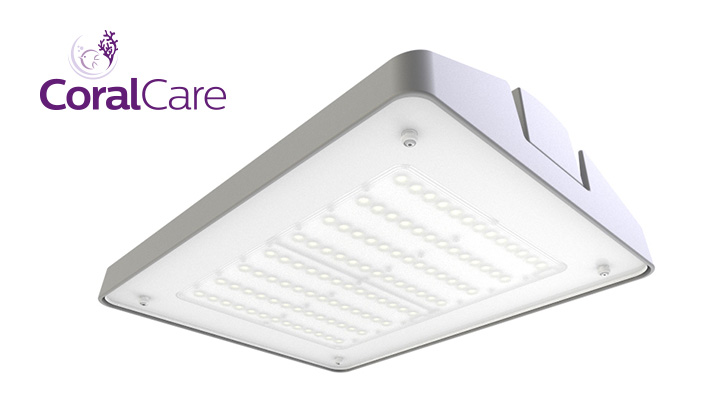Lighting serves multiple functions over our reef tank. We need to supply the photosynthetic organisms we keep with the right amount of energy and of course, we want our tanks to look as impressive as possible. There is a plethora of options to light your tank and non-aquarium brand Philips decided to introduce an aquarium led light as well: Philips Coralcare.
At a symposium in Belgium, Luc Vogels, a reefer and CoralCare lead design engineer at Philips Lighting, introduced the LED fixture to a large group of reefers (including myself). Although the phrase ‘a new LED light’ might sound like something you have heard before, his talk was very interesting. Obviously, a lot of thinking went into this light.
Being a world leader in lighting solutions, it is no surprise that Philips is able to produce a fixture that delivers a different solution to durability and efficiency. This of course does not make Philips a specialist in aquarium LED lighting. The people behind the idea of making an aquarium fixture also realized this, and obviously a lot of thinking, testing and research went into this fixture. Their own engineers worked together with hobbyists and marine biologists to create a lamp that, as they say, will change the way we look at aquarium lighting.

Some information from Luc Vogels’ talk: Blue light is known to deliver a lot of energy to corals. Thus, it would be logical to make a very blue light to deliver a lot of photons in an efficient way. This would make the light look very blue to the human eye. As a solution, the engineers included a lot of 420 nm light in the spectrum instead of 455 nm which is more common and cheaper. As the human eye is much less sensitive to 420 nm, the fixture delivers more photons to the corals without looking too blue.
While many manufacturers tout ‘gimmicks’ such as thunder lighting, clouds and so on, Philips choose another route: simplicity. You can choose color points and intensity during multiple points in the day and by doing so easily set a program to your liking. For example, a program could look like this: the day will start with blueish light, than increase the intensity while also changing to a more white spectrum and at the end of the day, the sunset will be blueish again.

After enjoying the fluorescence of the corals, the light slowly dims down to zero percent. Due to the simplified controls (setup of colorpoint and not an individual value for each of the five LED types) the Philips engineers claim that you do not have to worry about setting incorrect spectral content that could harm your corals. Within the range of color points it tries to balance an optimum between coral growth (useful light for the corals) and natural reef appearance (correct color rendering of fish and corals).
Many LED fixtures are very small. While this might seem to be handy for the reefer, self-shadowing in large coral colonies can be the side effect. The Coralcare unit is just large: it measures 45 – 35 centimetres and most of the underside is covered with 104 powerful Luxeon LEDs. The Philips units don’t only have a large spread of the LEDS, they also have something else: a feature called light guide.
This technology together with a milky glass cover is designed for these lights. It offers a very good combination between spotlight and diffusion. There is more shimmer than with T5, but way more spread than with most other LED fixtures, thus avoiding the problem of self shadowing. The lights mimic the classic combination between Metal Halide and T5 very well.

The fixture does not contain any fans, so it is completely silent and nearly maintenance-free. As the fixtures lack any fans and rely on passive cooling, it was possible to make the fixtures nearly water tight. While no-one will want to run his fixture underwater, splashes can and will occur sooner or later. This is tested under strict conditions and accidentally demonstrated during the Interzoo in May 2016 when one of the fixtures fell in the Philips’ show aquarium. The fixture withstood this test gloriously. The fixture is made of massive amounts of heat dissipating metal, weighing about 10 kilograms.
The LED’s used are designed to be ran at 5 watts each, but are driven at approximately 2 watts, so only at about 40%. By limiting the power in the LED’s, efficiency and life span are improved. The fixtures can be dimmed using a special controller that can be connected up to 4 Coralcare LED lights. The controller can either be programmed by software on a Windows computer or by connecting it to most common aquarium computers.

Before entering the market, the fixtures were tested over multiple tanks, both in laboratory and in ‘real life’ settings. The results of some of those tests can be found on Philips’ website. Here, technical info such as the spectra, LED layout and light distribution is also presented in a transparent way.
Our first impressions of these lights are very positive. Installing the software on the computer was a breeze so we could quickly see the optical effect on the tank. Color rendition of the animals is very good and so is the spread of light. Two Coralcare fixtures of 190 watts each are easily capable of supplying our large 600 litre mixed reef tank. Clams and sps on the bottom of the tank (with a water level of 80 centimeters) seem to be happy.
Of course, it is easy to hang some light over a nice reef tank to take some nice pictures and to conclude the lights are good. That is not a proper test. In the next article, we will look back on our hands-on experiences of the first four months of using these lights over a ‘real’ reef aquarium.





